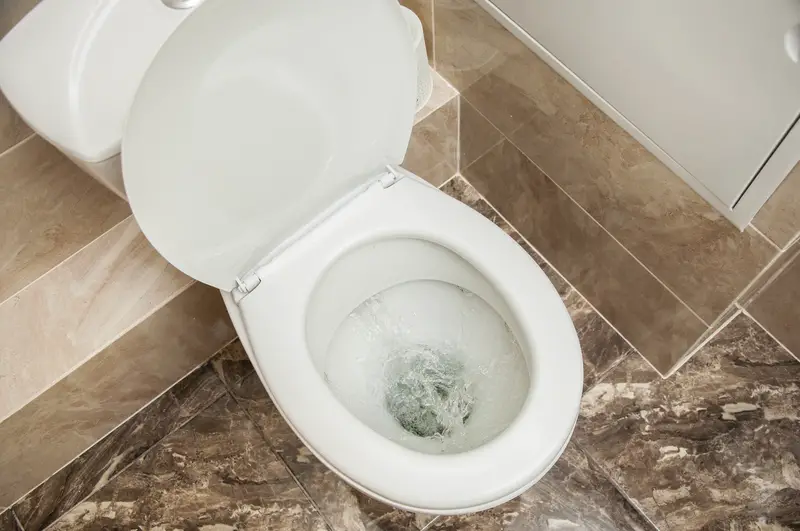That strange noise coming from the bathroom at 2 AM isn’t your house settling – it’s your toilet trying to tell you something important. Most homeowners ignore the early warning signs until they’re ankle-deep in water or facing a four-figure repair bill. Understanding what your toilet is communicating can save thousands of dollars and prevent embarrassing situations when guests visit.
Your toilet runs constantly even when not in use
The sound of water continuously running in your toilet tank signals a problem that’s literally flushing money down the drain. This issue typically stems from a faulty flapper valve that can’t properly seal the tank, allowing water to constantly flow from the tank into the bowl. A running toilet can waste up to 200 gallons of water per day, which translates to an extra $35 monthly on your water bill.
The culprit is usually a warped or mineral-encrusted flapper that won’t sit flush against the valve seat. Sometimes the chain connecting the flush handle to the flapper becomes too long or short, preventing proper closure. Fill valve replacement is often the most cost-effective solution, though checking the flapper and chain adjustment should be your first step in troubleshooting this water-wasting problem.
Strange noises happen when nobody’s using it
Mysterious toilet sounds – vibrating, whistling, or whooshing – occurring when no one is in the bathroom indicate internal component failures that need immediate attention. These eerie noises often happen at night when the house is quiet, making them seem more dramatic than they actually are. Vibrating sounds usually point to a malfunctioning fill valve, while whistling typically means the same component is struggling to regulate water flow properly.
Whooshing sounds that occur only during tank refilling often indicate calcium buildup from hard water, restricting normal water flow through the system. Professional cleaning may be necessary to remove mineral deposits that accumulate over time. Ignoring these sounds leads to complete component failure and potentially more expensive repairs when the toilet stops working entirely during the most inconvenient moments.
Frequent clogging happens with normal use
Finding yourself reaching for the plunger multiple times per week indicates a serious underlying problem that goes beyond typical toilet maintenance. Normal toilet use should never require constant plunging, and this frustrating situation often points to partial blockages in the drain line, mineral buildup restricting water flow, or venting issues that prevent proper flushing action. Tree roots infiltrating sewer lines can also cause recurring clogs that seem impossible to resolve permanently.
Sometimes the issue is as simple as a partially closed water supply valve that limits flushing power, but more often it indicates mineral buildup from hard water or poorly designed older toilets that lack sufficient flushing force. Professional diagnosis can determine whether the problem requires drain cleaning, pipe repair, or complete toilet replacement to restore normal function and eliminate the embarrassment of constant plunging.
Persistent odors resist all cleaning efforts
A toilet that continues to smell despite thorough scrubbing and multiple cleaning products indicates problems beyond surface dirt and grime. Stubborn odors often originate from bacteria growing in the pipes, mold developing under the bowl rim, or sewer gases escaping through cracks or faulty seals. These smells can make your entire bathroom unpleasant and may indicate unsanitary conditions that standard cleaning methods cannot address effectively.
The most concerning cause of persistent toilet odors is a broken wax seal or cracked toilet bowl that allows sewer gases to escape into your bathroom. Even hairline cracks in the porcelain can lower water levels enough to break the seal that prevents gas infiltration. Professional inspection can identify whether the problem requires seal replacement, crack repair, or complete toilet replacement to eliminate health hazards and restore bathroom freshness.
Water leaks appear around the base
Water pooling around your toilet base represents one of the most serious plumbing problems homeowners can face, as this contaminated water poses health risks and can cause extensive floor damage. Unlike clean water leaks from supply lines, base leaks typically involve contaminated water from the toilet bowl, creating unsanitary conditions that require immediate attention. The water can seep into subfloring, causing rot, mold growth, and structural damage that becomes exponentially more expensive to repair over time.
Most base leaks result from a failed wax ring seal or loose mounting bolts that no longer secure the toilet firmly to the floor. Damaged bolts or deteriorated wax seals allow water to escape during each flush, creating ongoing moisture problems that compromise bathroom flooring and potentially spread to adjacent rooms. Professional repair typically involves removing the entire toilet to replace the wax seal and ensure proper mounting.
The toilet tank develops condensation problems
Excessive condensation forming on your toilet tank exterior might seem harmless, but this “sweating” toilet creates moisture problems that can damage bathroom floors, walls, and nearby fixtures. The condensation occurs when warm, humid bathroom air contacts the cold surface of the toilet tank, creating droplets that continuously drip onto the floor. Over time, this constant moisture can warp flooring, promote mold growth, and cause paint to peel from nearby walls.
The underlying cause is often a leaky toilet flapper that allows cold water to constantly flow into the tank, keeping the exterior surface cooler than room temperature. Installing tank insulation or an anti-sweat valve can resolve the problem by warming the tank water to closer to room temperature. These solutions prevent the temperature differential that causes condensation while protecting your bathroom from ongoing moisture damage.
Flushing becomes weak or incomplete
A toilet that barely moves waste or requires multiple flushes to clear the bowl indicates serious problems with water flow, drain blockages, or internal component failures. Weak flushing makes the toilet essentially unusable for its intended purpose and often leads to embarrassing situations when guests encounter a toilet that won’t properly clear waste. This problem typically worsens over time as underlying blockages become more severe or internal components continue to deteriorate.
The issue commonly stems from clogged trap or drain lines that restrict water flow, preventing adequate flushing action from reaching the bowl. Mineral buildup, debris accumulation, or partial blockages can gradually reduce flushing effectiveness until the toilet becomes unreliable. Professional drain cleaning or component replacement may be necessary to restore proper flushing power and prevent the frustration of multiple flush attempts.
The toilet feels unstable or wobbly
A toilet that rocks or shifts when you sit down poses safety risks and indicates mounting problems that can lead to serious water damage if left unaddressed. The instability usually results from loose mounting bolts, a deteriorated wax ring, or floor damage from previous leaks that have compromised the toilet’s foundation. Using an unstable toilet is not only uncomfortable but dangerous, as the movement can cause injuries or sudden component failures.
The rocking motion often breaks the wax seal between the toilet and the floor drain, leading to water leaks that damage flooring and create unsanitary conditions. Professional repair typically involves removing the toilet to inspect the flange, replace the wax ring, and ensure proper mounting with new bolts. Ignoring toilet instability almost always results in water damage that costs significantly more to repair than addressing the mounting issue promptly.
Discolored water appears in the bowl
Water in your toilet bowl should always be clear, so any discoloration indicates potential contamination or pipe corrosion that requires immediate investigation. Rusty brown water typically signals iron corrosion in the pipes, while blue or green tints often indicate copper pipe deterioration that can affect water quality throughout your home. Black or gray water may indicate sewage backup or serious contamination that poses immediate health risks to your family.
Discolored toilet water often reflects broader plumbing system problems that extend beyond just the toilet itself, potentially affecting drinking water and other fixtures throughout the house. Contamination in toilet water can cause infections and other health problems, making professional diagnosis essential to identify the source and extent of the problem. Water quality testing and pipe inspection may be necessary to ensure your entire water system is safe and properly functioning.
Recognizing these warning signs early can prevent minor toilet problems from becoming major disasters that disrupt your daily routine and drain your bank account. Most toilet issues start small but quickly escalate when ignored, turning simple repairs into complete bathroom renovations. Taking action at the first sign of trouble protects your home, saves money, and ensures your bathroom remains functional when you need it most.

